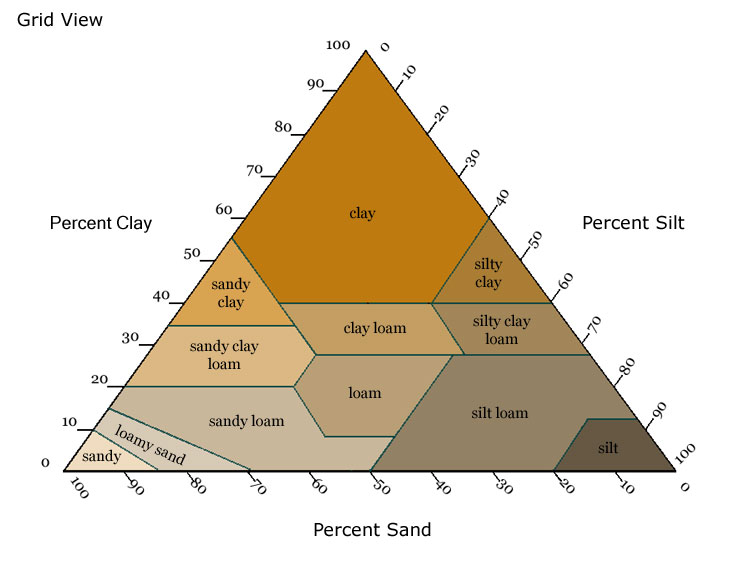Soil Triangle
The soil triangle is a tool that can help you do two things, you can find the
texture type when given percentages of sand, silt, and clay or if you have the
texture type you can approximate the percentages. Knowing the texture type of a
soil will help determine the usage of a particular land and wither or not you
realized it, soil’s texture affects your every day life. To learn more about
texture and particle size, you can go to the Soils page.
Using the Triangle
Each side of the triangle has a scale of 0 to 100 percent. Whenever you use a new triangle it is a good idea to take a moment and fimilarize youself with it because all triangles may not have the exact layout. The triangle used here has Clay on the left, Silt on the right and Sand at the bottom. Some triangles will have no visable grid making it easier to see the area of each texture and some will have a grid to help find the texture by precentage values.
Starting with clay, its numbers are horozontal implying they horozontally divide the triangle. Likewise, silt and sand have numbers are they angled and imply the direction their lines are read across the triangle. By clicking Percent Clay, Percent Silt, and Percent Sand in the picture, lines will highlight to make it easier for you to see how the lines in each section divide the triangle.
Click headings in the image to change the view.Using the Triangle
Each side of the triangle has a scale of 0 to 100 percent. Whenever you use a new triangle it is a good idea to take a moment and fimilarize youself with it because all triangles may not have the exact layout. The triangle used here has Clay on the left, Silt on the right and Sand at the bottom. Some triangles will have no visable grid making it easier to see the area of each texture and some will have a grid to help find the texture by precentage values.
Starting with clay, its numbers are horozontal implying they horozontally divide the triangle. Likewise, silt and sand have numbers are they angled and imply the direction their lines are read across the triangle. By clicking Percent Clay, Percent Silt, and Percent Sand in the picture, lines will highlight to make it easier for you to see how the lines in each section divide the triangle.

Let's Practice
Now that you understand the layout of the triangle, let's practice using it. If you want to find a texture that has 20 percent sand, 70 percent silt and 10 percent clay, click Grid View and then trace the value of each line until they meet. Click here to see if you are correct.
